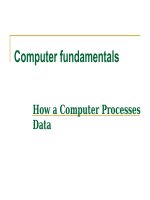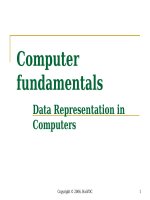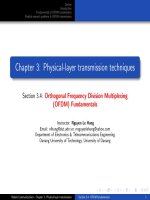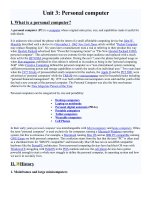Computer fundamentals
Bạn đang xem bản rút gọn của tài liệu. Xem và tải ngay bản đầy đủ của tài liệu tại đây (880.92 KB, 31 trang )
How a Computer Processes Data
Computer fundamentals
Copyright © 2006, HaiVD
C
2
Objectives
Identify computer system components.
Explain how the CPU works.
Differentiate between RAM and ROM.
Describe how data is represented.
Copyright © 2006, HaiVD
C
3
Computer System Components
A computer system requires many components
to do its job:
It requires some device or method to input data so it
can be processed.
It requires circuits and programs in order to process
the data.
It needs some type of output device to give the result
of its processing to the user.
It needs some mechanism for storing data.
Copyright © 2006, HaiVD
C
4
Common System Components
This figure shows
several devices that
are common com-
ponents of a com-
puter system.
Copyright © 2006, HaiVD
C
5
System Motherboard
Inside the case of a modern PC is the motherboard, which
contains the electronic circuitry of the computer.
Components found on the motherboard include
The primary processing chip (CPU).
The memory chips.
Expansion slots for system interface cards.
Ports for connecting external devices.
BIOS chips that control system start-up.
The circuitry that enables all of these components to
communicate.
Copyright © 2006, HaiVD
C
6
Example of a Motherboard
This figure shows the
devices inside a PC
case, including the
motherboard, the
power supply, and
some storage devices.
Copyright © 2006, HaiVD
C
7
The Central Processing Unit
The CPU is the brains of a computer system.
The CPU is housed on a silicon chip that contains millions of
switches and circuits.
The CPU has two primary sections:
Arithmetic/Logic Unit (ALU)
This section performs arithmetic and logical operations.
Control Unit
This section is the boss of the CPU and coordinates all activity
within the CPU. It uses programming instructions to control
what actions the CPU performs and when it performs them.
Copyright © 2006, HaiVD
C
8
A CPU Chip
This figure shows a CPU chip for a
small computer. The CPU determines
which of the millions of switches that
it contains should be turned on or off
by processing program statements
that tell it what to do.
Computer programs are written in
programming languages, and each
program statement causes one or more
actions to occur in the CPU.
Copyright © 2006, HaiVD
C
9
Original chips were numbered
8086, 80286, 80386, 80486
You could buy chips from multiple vendors
Intel trademarked its chip as the Pentium
Pentium II, Pentium III, Pentium IV
Clock speed (MHz or GHz) differentiates chips
The central processing unit (cpu) or “brain”
of the PC
The Microprocessor
Copyright © 2006, HaiVD
C
10
Computer Memory
Data being processed by a CPU is stored in system
memory.
Memory consists of addressable locations within the
machine that the computer can access directly.
Data stored in memory is not permanent. If the power
fails, everything in memory is lost.
Data must be stored on a disk or some other device
when not being processed so it is not lost each time the
computer shuts down.
Copyright © 2006, HaiVD
C
11
Types of Memory
RAM – Random Access Memory
This is short-term memory where data is processed while a program
is running.
Data stored here can be accessed and modified as needed.
This type of memory loses any data it holds if the computer is shut
down.
ROM – Read-Only Memory
ROM is memory placed on the motherboard by the manufacturer and
contains instructions that tell the computer how to start itself.
This data cannot be accessed or modified by application programs.
The contents of this memory are not lost when the computer is shut
down.
Copyright © 2006, HaiVD
C
12
Auxiliary Storage
Floppy Disk
No longer standard
Hard (fixed) disk
30 Gb and higher
5400rpm, 7200 rpm
Removable storage
CD-ROM
CD-R/CD-RW
DVD/DVD-R/DVD-RW
(Digital Video Disk HD)
Zip disks
Tape









